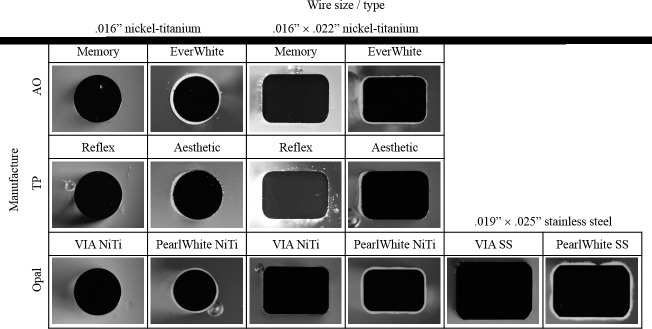Abstract
Objective:
To analyze the coatings covering esthetic orthodontic wires and the influence of such coatings on bending and frictional properties.
Materials and Methods:
Four commercially available, coated esthetic archwires were evaluated for their cross-sectional dimensions, surface roughness (Ra), nanomechanical properties (nanohardness, nanoelastic modulus), three-point bending, and static frictional force. Matched, noncoated control wires were also assessed.
Results:
One of the coated wires had a similar inner core dimension and elasticity compared to the noncoated control wire, and no significant differences between their static frictional forces were observed. The other coated wires had significantly smaller inner cores and lower elasticity compared to the noncoated wires, and one of them showed less static frictional force than the noncoated wire, while the other two coated wires had greater static frictional force compared to their noncoated controls. The dimension and elastic modulus of the inner cores were positively correlated (r = 0.640), as were frictional force and total cross-sectional (r = 0.761) or inner core (r = 0.709) dimension, elastic modulus (r = 0.777), nanohardness (r = 0.802), and nanoelastic modulus (r = 0.926). The external surfaces of the coated wires were rougher than those of their matched controls, and the Ra and frictional force were negatively correlated (r = −0.333).
Conclusions:
Orthodontic coated wires with small inner alloy cores withstand less force than expected and may be unsuitable for establishing sufficient tooth movement. The frictional force of coated wires is influenced by total cross-section diameter, inner core diameter, nanohardness, nanoelastic modulus, and elastic modulus.
Keywords: Coating, Archwires, Bending, Friction, Mechanical properties, Cross-sectional dimension
INTRODUCTION
Esthetically attractive orthodontic materials are desirable, especially for adults.1,2 Although esthetic brackets made from plastic or ceramics are widely used for orthodontics,3 most orthodontic archwires are made of metal. Therefore, esthetic archwires that complement brackets are highly desired for clinical orthodontics.1 To this end, polymer wires with glass-fiber reinforcements have been investigated4–7 but have yet to be used widely because of their brittleness and inability to withstand sufficient force.4–6 Coated archwires, including metal wires coated with polymers, or rhodium-plated wires, have been developed2,8–17 and are preferred by many patients because of their improved esthetic qualities.16
The coating of orthodontic archwires is expected to influence their surface characteristics, and, therefore, the properties of such archwires, including their thickness,9 surface roughness,2,11,17 bacterial adhesion,11 mechanical properties,2,9,10,12,14,15,17 corrosiveness,12 scratch resistance,15 coating stability,10 and frictional properties,13,16 have been investigated. Although a previous study2 demonstrated a significant increase in force values for the polymer-coated archwires compared to noncoated archwires, other studies8,10 reported that coated archwires produce generally lower force values compared to noncoated archwires. On the other hand, the previous study9 concluded that the reduction in the inner alloy core dimensions seems to be the variable responsible for greater changes in the mechanical properties of coated archwires, along with variations in the materials' properties.
The frictional force between the bracket and archwire is a primary issue in orthodontics because it limits tooth movement.18,19 The few studies13,16 that investigated the frictional properties of coated archwires primarily focused on the relationship to surface roughness. Recently9 it was shown that the dimensions of the inner core and coating thickness influence the wire's mechanical properties. Although the cross-sectional dimensions of the inner core and coating and the mechanical properties of the archwire are expected to influence friction, only limited information is available on this topic.
In this study, the cross-sectional geometry, surface roughness, and nanomechanical properties of four coated orthodontic archwires were analyzed for their bending and frictional properties.
MATERIALS AND METHODS
Materials
Four coated orthodontic archwires (EverWhite, American Orthodontics, Sheboygan, Wis; Reflex Nickel Titanium Aesthetic Wire, TP Orthodontics, La Porte, Ind; VIA Wires Pearl Esthetic Superelastic NiTi, Opal Orthodontics, South Jordan, Utah; and VIA Wires Pearl Esthetic Stainless Steel, Opal Orthodontics) with cross-section dimensions of 0.016 inches, 0.016 × 0.022 inches, or 0.019 × 0.025 inches were analyzed. Matched, noncoated control wires from the same manufacturers were used for comparison. Shown in Table 1 are the product codes, manufacturers, and nominal cross-sectional dimensions for each wire investigated.
Table 1.
Orthodontic Wires Used in the Present Study
| Product (Code) |
Manufacturer |
Coating |
Cross-Section Dimension, inches |
|||
| Coated |
Noncoated |
0.016 |
0.016 × 0.022 |
0.019 × 0.025 |
||
| Superelastic Titanium Memory Wire (Memory) | American Orthodontics (AO) | ° | ° | ° | ||
| EverWhite (EverWhite) | ° | ° | ° | |||
| Reflex Nickel Titanium (Reflex) | TP Orthodontics (TP) | ° | ° | ° | ||
| Reflex Nickel Titanium Aesthetic wire (Aesthetic) | ° | ° | ° | |||
| VIA Wires Superelastic NiTi (VIA NiTi) | Opal Orthodontics (Opal) | ° | ° | ° | ||
| VIA Wires Pearl Esthetic Superelastic NiTi (PearlWhite NiTi) | ° | ° | ° | |||
| VIA Wires Stainless Steel (VIA SS) | ° | ° | ||||
| VIA Wires Pearl Esthetic Stainless Steel (PearlWhite SS) | ° | ° | ||||
Microscopic Assessments of Cross-Section Surfaces
Each wire was encapsulated in an epoxy resin (Epofix, Struers, Copenhagen, Denmark), and the surface was ground and polished using a series of silicon carbide abrasive papers, followed by a final slurry of 0.05-μm alumina particles. Cross-sectional microscopic analyses (n = 5) were performed using a SMZ1500 microscope (Nikon, Tokyo, Japan), and the areas of the inner core and coating layer were estimated using imaging software (Win Roof, Mitani, Tokyo, Japan).
Evaluation of Surface Roughness
The external surfaces of the wires (n = 5) were examined using atomic force microscopy (AFM; SPM-9500J2, Shimadzu, Kyoto, Japan). The average surface roughness (Ra) was calculated using the software supplied with the AFM.
Nanoindentation Test
Nanoindentation tests (n = 7) were performed to evaluate the mechanical properties of the cross-sectional surfaces (ENT-1100a, Elionix, Tokyo, Japan), nanohardness (NH), and the nanoelastic modulus (NEM) for each wire's inner core and coating. Each sample was encapsulated in an epoxy resin, and the surface was ground and polished using a series of silicon carbide abrasive papers, followed by a final slurry of 0.05-μm alumina particles. Next, samples were fixed to the specimen stage using an adhesive resin (Superbond Orthomite, Sun Medical, Shiga, Japan), and nanoindentation testing was performed at 28°C using a Berkovich indenter with a peak load of 5 mN. The NH and NEM were calculated using software specific to the nanoindentation instrument and following the ISO 14577-1 guidelines.
Three-Point Bending Test
Three-point bending tests (n = 10) were performed using a 12-mm span size, in accordance with ADA Specification No. 32 (ANSI/ADA Specification No. 32, 2000) (Figure 1). Samples were loaded onto a universal testing machine (EZ Test, Shimadzu) with a 20-N load cell (EZ Test, Shimadzu). The temperature was maintained at 37°C ± 0.5°C. Each wire was then subjected to a deflection of 3 mm (loading process), followed by unloading (unloading process) at a rate of 0.5 mm/min. The elastic modulus was then calculated using software provided with the universal testing machine (Trapezium 2, Shimadzu).
Figure 1.
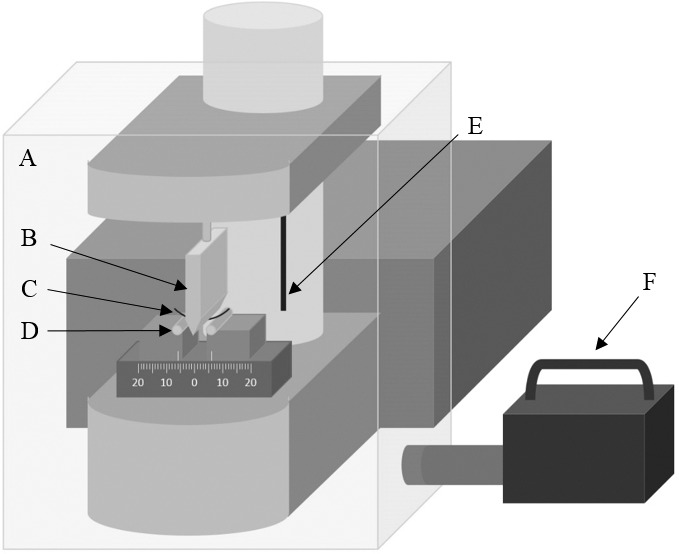
Illustration of the three-point bending test device. A, thermal screen; B, indenter; C, wire sample; D, supporting points; E, temperature sensor; and F, hot-air circulation temperature controller.
Friction Test
The static frictional force generated with each wire/bracket combination was tested (n = 10) under dry conditions at 25°C using a custom-fabricated friction-testing device attached to the universal testing machine (EZ Test, Shimadzu).20 Each bracket was bonded to a stainless-steel plate using a bracket-mounting device with a nonfilled adhesive resin (Superbond, Sun Medical, Shiga, Japan), and the bracket was positioned at 10°. A 5-cm segment of wire was then ligated to the bracket using an elastomeric ligature (Alastik Easy-To-Tie Ligatures, 3M Unitek, Monrovia, Calif). The upper end of the wire was then fixed to a 150-g weight and each wire was drawn through the bracket at a crosshead speed of 10 mm/min for a distance of 5 mm. The static frictional force was then determined from the load-displacement curves, and microscopic analyses were performed on the coated archwires after testing.
Statistical Analysis
Statistical analyses were performed using SPSS 22 (IBM, Armonk, NY). The Levene test was used to assess normality within the data. Mean surface roughness, elastic modulus, frictional force, NH, and NEM were compared using the Student's t-test. The mean NH and NEM values were also compared using a one-way analysis of variance with the Tukey's test. Relationships between the cross-sectional dimensions, (eg, inner alloy core and coating layer diameters), Ra, elastic modulus, NH, NEM, and static friction force were assessed using the Pearson correlation coefficient test.
RESULTS
Cross-sectional micrographs of all wires are shown in Figure 2. EverWhite and PearlWhite (NiTi and stainless) wires were coated over the entire surface; however, only the labial side was coated on the esthetic wires. The layer of coating on the labial side of the EverWhite wires was thicker than on the other sides, while the coating for PearlWhite NiTi and SS wires were of uniform thickness. Reflex and Aesthetic wires from the same manufacturer had similar inner alloy core dimensions (Table 2), while the other coated wires were significantly smaller than their matched, noncoated controls.
Figure 2.
Cross-sectional micrographs of wires from the labial (left side) and lingual surfaces (right side). Magnification: 240×.
Table 2.
Total Cross-Section and Inner Core Dimensions of Orthodontic Wire Used in the Present Study
| Wire Size/Type |
Manufacturera |
Product |
Total Cross-Section Dimensions, mm2 |
Inner Core Dimensions, mm2 |
Nominal Cross-Sectional Dimension, mm2 |
||
| Mean |
SD |
Mean |
SD |
||||
| 0.016-inch Nickel-titanium | AO | Memory | 0.1259 | 0.0006 | 0.1297 | ||
| EverWhite | 0.1425 | 0.0008 | 0.1151 | 0.0003 | |||
| TP | Reflex | 0.1292 | 0.0013 | ||||
| Aesthetic | 0.145 | 0.0021 | 0.133 | 0.002 | |||
| Opal | VIA NiTi | 0.1235 | 0.0006 | ||||
| PearlWhite NiTi | 0.1184 | 0.0011 | 0.0983 | 0.0011 | |||
| 0.016 × 0.022-inch Nickel-titanium | AO | Memory | 0.2205 | 0.0005 | 0.2271 | ||
| EverWhite | 0.2191 | 0.0021 | 0.1905 | 0.0018 | |||
| TP | Reflex | 0.2149 | 0.0022 | ||||
| Aesthetic | 0.2296 | 0.002 | 0.2185 | 0.0017 | |||
| Opal | VIA NiTi | 0.2148 | 0.0022 | ||||
| PearlWhite NiTi | 0.2058 | 0.0004 | 0.17 | 0.0003 | |||
| 0.019 × 0.025-inch Stainless steel | Opal | VIA SS | 0.3011 | 0.0011 | 0.3065 | ||
| PearlWhite SS | 0.3102 | 0.002 | 0.2691 | 0.0014 | |||
AO indicates American Orthodontics; TP, TP Orthodontics.
Figure 3 reflects the average Ra values for all wires. As expected, the external surfaces of coated wires were rougher than those of the noncoated controls.
Figure 3.

Comparisons of surface roughness (Ra). Values for each specimen were obtained using AFM. Values represent the mean ± SD. n = 5. * P < .05.
Shown in Figures 4 through 6 are the average nanomechanical properties (NH, NEM) of the inner cores and coating layers. The average NH and NEM for the inner cores were the same between coated and noncoated wires, while the average NEM for coating layer of the PearlWhite SS wires was significantly less than for the other coated wires.
Figure 4.

Comparisons of nanohardness (NH). Each sample was assessed using the nanoindentation test. Values represent the mean ± SD. n = 7. * P < .05.
Figure 6.
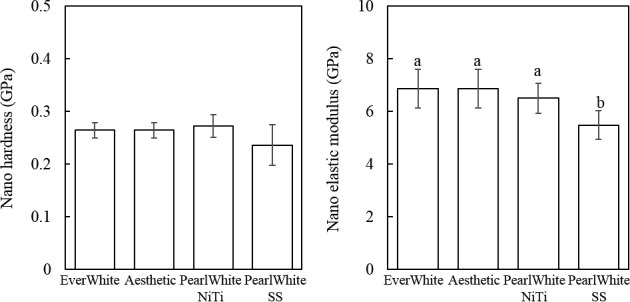
NH and NEM for the coatings of each wire. Values represent the mean ± SD. n = 7. * P < .05 (Tukey test).
Figure 5.

Comparison of elastic moduli (NEM). Each sample was assessed using the nanoindentation test. Values represent the mean ± SD. n = 7. * P < .05.
Figure 7 shows the average elastic modulus obtained using the three-point bending test. With the exception of the Reflex and Aesthetic wires, all coated wires had a lower elastic modulus than did the noncoated control wires.
Figure 7.
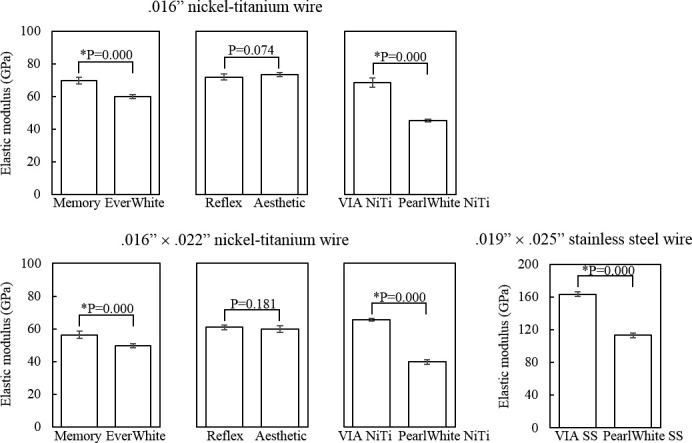
Elastic modulus of each sample using the three-point bending test. Upper, 0.016-inch nickel-titanium wire; lower, 0.016 × 0.022-inch nickel-titanium wire; 0.019 × 0.025-inch stainless-steel wire.
Shown in Figure 8 is the average static frictional force for each wire. The EverWhite wires had higher static friction than did their noncoated controls, while the Reflex and Aesthetic wires did not. PearlWhite NiTi wires had lower static frictional force than did their noncoated control wires (VIA NiTi), while the PearlWhite SS wires had a greater static frictional force than their noncoated control wires (VIA SS). Following the friction test, micrograph images of the PearlWhite SS wires were obtained and revealed that the coating had been removed from the inner core (Figure 9). None of the coatings for the other wires were damaged or removed upon frictional testing (not shown).
Figure 8.
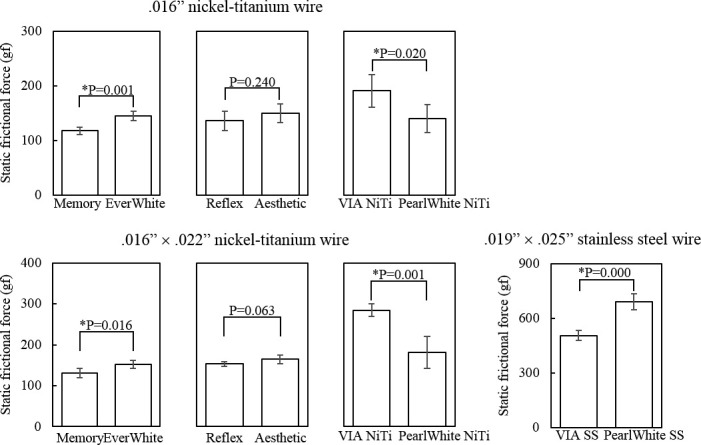
Static frictional force of each wire. Upper, 0.016-inch nickel-titanium wire; middle, 0.016 × 0.022-inch nickel-titanium wire; lower, 0.019 × 0.025-inch stainless-steel wire.
Figure 9.
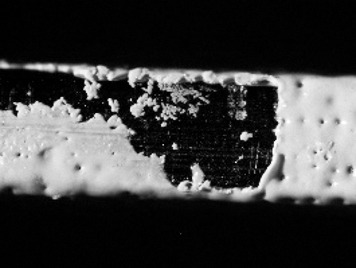
Optical microscope image of the PearlWhite SS sample after the friction test. The coating was removed from the inner core upon the application of friction. Magnification: 144×.
DISCUSSION
During tooth movement, the friction between the bracket and the archwire is a primary concern.19,20 Characteristics such as surface roughness, hardness, and elastic modulus depend on the wire's composition, thermal history, and cross-sectional dimensions. These characteristics also influence bending and frictional properties.2,8–14,17
In this study, the Reflex (noncoated) and Aesthetic (coated) wires had a similar elastic modulus, which agrees with previous findings.9 No significant differences between their static frictional forces were observed, however, which can be attributed to multiple factors, including the low elastic modulus of the coating layer (NEM), their similar cross-sectional dimensions, and the elastic modulus. Notably, the only difference between the two wires was the labial surface coating of the Aesthetic wire. Conversely, the EverWhite (0.016-inch and 0.016 × 0.022-inch nickel-titanium) and PearlWhite (0.016-inch and 0.016 × 0.022-inch nickel-titanium and 0.019 × 0.025-inch stainless-steel) wires had smaller cross-sectional dimensions and a lower elastic modulus obtained using the three-point bending test as well as similar nanomechanical properties (NH, NEM) of their inner core compared to the noncoated control wires.
The diameter of the inner core and the elastic modulus were correlated in this study (r = 0.640). The PearlWhite NiTi wires had less static frictional force than did the matched, noncoated control wire (VIA NiTi), while the PearlWhite SS and EverWhite wires (Table 3) had greater static frictional force compared to their noncoated controls (VIA SS and Memory). These differences may have been due to different coating characteristics, including the elastic modulus or the bond strength between the coating layer and the inner core. The high elastic modulus of the PearlWhite SS wire may also increase wire-binding at the edge of the bracket, which would increase friction. This hypothesis is consistent with scanning electron microscope images of the PearlWhite SS wire after friction testing, in which the coating layer was removed from the inner core (Figure 9).
Table 3.
Pearson's Correlation Coefficient Among the Cross-Sectional Dimensions, Inner Core Dimension, Friction Force, Elastic Modulus, Surface Roughness (Ra), Nanohardness (NH), and Elastic Modulus (NEM)
|
|
Total Cross-Sectional Dimensions |
Inner Core Dimension |
Friction Force |
Elastic Modulus |
Ra |
NH |
NEM |
| Total cross-sectional dimensions | 1 | ||||||
| Inner core dimension | 0.971 | 1 | |||||
| Friction force | 0.761 | 0.709 | 1 | ||||
| Elastic modulus | 0.583 | 0.639 | 0.777 | 1 | |||
| Ra | −0.338 | −0.468 | −0.333 | −0.486 | 1 | ||
| NH | 0.933 | 0.874 | 0.802 | 0.889 | −0.386 | 1 | |
| NEM | 0.976 | 0.89 | 0.926 | 0.933 | −0.422 | 0.936 | 1 |
Previous studies2,11,15,17 that evaluated the Ra of coated wires focused on bacterial adhesion, plaque accumulation, corrosion, and frictional properties. Consistent with those studies, we found that the surfaces of coated wires were rougher than those of their noncoated control wires.11,13 In addition to surface roughness, other factors, including hardness, elastic modulus, the thickness of the coating, the elastic modulus of the inner core, cross-sectional diameter, and the environment (dry or wet), can all influence friction. In fact, the relationship between frictional force and the cross-sectional (r = 0.761) or inner core (r = 0.709) diameters, the elastic modulus (r = 0.777), NH (r = 0.802), and NEM (r = 0.926) were positively correlated. Unexpectedly, however, the Ra and frictional force were negatively correlated (r = −0.333).
Although the inner core of the Aesthetic wire was similar in dimension to that indicated by the manufacturer, all other wires were smaller than indicated by the manufacturer.9 The mechanical properties of archwires, including the orthodontic force, depend on their alloy compositions and cross-sectional dimensions.21 The accuracy of the cross-sectional dimensions is important8 since wire dimensions influence tooth leveling, aligning, and torqueing. The wire coatings assessed in this study were extremely soft, with low elastic modulus. This may reduce control of tooth movement and increase friction between the bracket and wire. Thus, development of coated wires with thin coatings and high elastic modulus and ductility are required.
CONCLUSIONS
-
•
Esthetic coated wires with small inner cores may produce less orthodontic force than expected.
-
•
Friction of the coated wires was influenced by the total cross-sectional and inner core dimensions, inner core nanohardness, inner core elastic modulus, and elastic modulus, but not by surface roughness.
REFERENCES
- 1.Eliades T, Eliades G, Brantley WA. Orthodontic brackets. In: WA Brantley, Eliades T., editors. Orthodontic Materials: Scientific and Clinical Aspects. Stuttgart, Germany: Thieme; 2001. pp. 143–172. [Google Scholar]
- 2.Iijima M, Muguruma T, Brantley W, et al. Effect of coating on properties of esthetic orthodontic nickel-titanium wires. Angle Orthod. 2012;82:319–325. doi: 10.2319/021511-112.1. [DOI] [PMC free article] [PubMed] [Google Scholar]
- 3.Lopes Filho H, Maia LE, Araújo MV, Ruellas AC. Influence of optical properties of esthetic brackets (color, translucence, and fluorescence) on visual perception. Am J Orthod Dentofacial Orthop. 2012;141:460–467. doi: 10.1016/j.ajodo.2011.10.026. [DOI] [PubMed] [Google Scholar]
- 4.Imai T, Yamagata S, Watari F, et al. Temperature-dependence of the mechanical properties of FRP orthodontic wire. Dent Mater J. 1999;18:167–175. doi: 10.4012/dmj.18.167. [DOI] [PubMed] [Google Scholar]
- 5.Zufall SW, Kusy RP. Sliding mechanics of coated composite wires and the development of an engineering model for binding. Angle Orthod. 2000;70:34–47. doi: 10.1043/0003-3219(2000)070<0034:SMOCCW>2.0.CO;2. [DOI] [PubMed] [Google Scholar]
- 6.Burstone CJ, Liebler SAH, Goldberg AJ. Polyphenylene polymers as esthetic orthodontic archwires. Am J Orthod Dentofacial Orthop. 2011;139:e391–e398. doi: 10.1016/j.ajodo.2009.05.030. [DOI] [PubMed] [Google Scholar]
- 7.Tanimoto Y, Inami T, Yamaguchi M, Nishiyama N, Kasai K. Preparation, mechanical, and in vitro properties of glass fiber-reinforced polycarbonate composites for orthodontic application. J Biomed Mater Res B Appl Biomater. 2015;103:743–750. doi: 10.1002/jbm.b.33245. [DOI] [PubMed] [Google Scholar]
- 8.Kaphoor AA, Sundareswaran S. Aesthetic nickel titanium wires—how much do they deliver? Eur J Orthod. 2013;34:603–609. doi: 10.1093/ejo/cjr089. [DOI] [PubMed] [Google Scholar]
- 9.da Silva DL, Mattos CT, Sant'Anna EF, Ruellas AC, Elias CN. Cross-section dimensions and mechanical properties of esthetic orthodontic coated archwires. Am J Orthod Dentofacial Orthop. 2013;143:S85–S91. doi: 10.1016/j.ajodo.2012.09.009. [DOI] [PubMed] [Google Scholar]
- 10.Bradley TG, Berzins DW, Valeri N, Pruszynski J, Eliades T, Katsaros C. An investigation into the mechanical and aesthetic properties of new generation coated nickel-titanium wires in the as-received state and after clinical use. Eur J Orthod. 2014;36:290–296. doi: 10.1093/ejo/cjt048. [DOI] [PubMed] [Google Scholar]
- 11.Kim IH, Park HS, Kim YK, Kim KH, Kwon TY. Comparative short-term in vitro analysis of mutans streptococci adhesion on esthetic, nickel-titanium, and stainless-steel arch wires. Angle Orthod. 2014;84:680–686. doi: 10.2319/061713-456.1. [DOI] [PMC free article] [PubMed] [Google Scholar]
- 12.Katić V, Curković HO, Semenski D, Baršić G, Marušić K, Spalj S. Influence of surface layer on mechanical and corrosion properties of nickel-titanium orthodontic wires. Angle Orthod. 2014;84:1041–1048. doi: 10.2319/090413-651.1. [DOI] [PMC free article] [PubMed] [Google Scholar]
- 13.Rudge P, Sherriff M, Bister D. A comparison of roughness parameters and friction coefficients of aesthetic archwires. Eur J Orthod. 2015;37:49–55. doi: 10.1093/ejo/cju004. [DOI] [PubMed] [Google Scholar]
- 14.Washington B, Evans CA, Viana G, Bedran-Russo A, Megremis S. Contemporary esthetic nickel-titanium wires: do they deliver the same forces? Angle Orthod. 2015;85:95–101. doi: 10.2319/092513-701.1. [DOI] [PMC free article] [PubMed] [Google Scholar]
- 15.da Silva DL, Santos E, Jr, Camargo Sde S, Jr, Ruellas AC. Infrared spectroscopy, nano-mechanical properties, and scratch resistance of esthetic orthodontic coated archwires. Angle Orthod. 2015;85:777–783. doi: 10.2319/070314-472.1. [DOI] [PMC free article] [PubMed] [Google Scholar]
- 16.Choi S, Park DJ, Kim KA, Park KH, Park HK, Park YG. In vitro sliding-driven morphological changes in representative esthetic NiTi archwire surfaces. Micro Res Tech. 2015;78:926–934. doi: 10.1002/jemt.22557. [DOI] [PubMed] [Google Scholar]
- 17.Ryu SH, Lim BS, Kwak EJ, Lee GJ, Choi S, Park KH. Surface ultrastructure and mechanical properties of three different white-coated NiTi archwires. Scanning. 2015;37:414–421. doi: 10.1002/sca.21230. [DOI] [PubMed] [Google Scholar]
- 18.Kusy RP, Tobin EJ, Whitley JQ, Sioshansi P. Frictional coefficients of ion-implanted alumina against ion-implanted beta-titanium in the low load, low velocity, single pass regime. Dent Mater. 1992;8:167–172. doi: 10.1016/0109-5641(92)90076-o. [DOI] [PubMed] [Google Scholar]
- 19.Burrow SJ. Friction and resistance to sliding in orthodontics: a critical review. Am J Orthod Dentofacial Orthop. 2009;135:442–447. doi: 10.1016/j.ajodo.2008.09.023. [DOI] [PubMed] [Google Scholar]
- 20.Muguruma T, Iijima M, Brantley WA, Ahluwalia KS, Kohda N, Mizoguchi I. Effects of third-order torque on frictional force of self-ligating brackets. Angle Orthod. 2014;84:1054–1061. doi: 10.2319/111913-845.1. [DOI] [PMC free article] [PubMed] [Google Scholar]
- 21.Brantley WA. Orthodontic wires. In: WA Brantley, Eliades T., editors. Orthodontic Materials: Scientific and Clinical Aspects. Stuttgart, Germany: Thieme; 2001. pp. 77–104. [Google Scholar]



